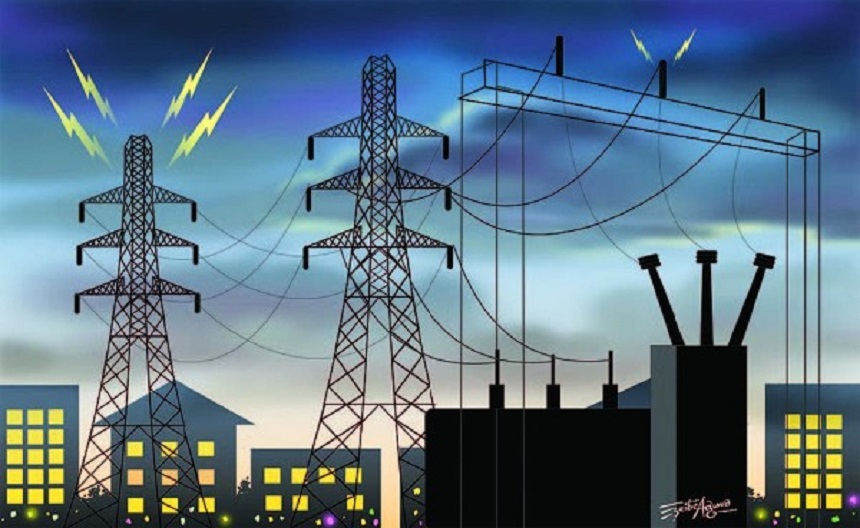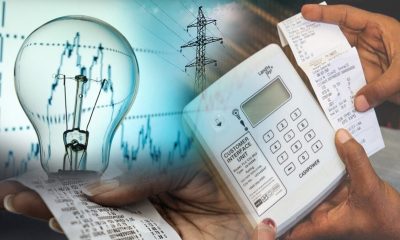General
ATC&C Losses of 11 DisCos Leap to 51%—Agusto

By Modupe Gbadeyanka
In 2020, the 11 electricity distribution (DisCos) operating in Nigeria recorded aggregate technical, commercial and collection (ATC&C) losses of 51 per cent, higher than 45 per cent in 2019.
The rise in ATC&C losses was largely due to the impact of the COVID-19 pandemic, a report by a local rating agency, Agusto & Co, stated, adding that this high loss level remains one of the many reasons for the kickback from electricity consumers on tariff increases, especially in the absence of a significant and immediate improvement in power supply.
The firm said last year, the energy companies only billed for 74 per cent of the energy received from the transmission company, lower than the 81 per cent reported in the prior year.
Billing efficiency, which has historically been impaired by a low metering rate and energy theft, with only 37 per cent of registered electricity customers metered in 2020, was severely impacted by the global health crisis, it added.
Agusto said it believes the impact of the pandemic was more visible amongst consumer groups with post-paid meters and estimated bills given that the social distancing rules and movement restrictions established to curb the spread of the virus impaired the physical billing process. Collection efficiency also fell marginally to 66 per cent from 68 per cent one year prior.
Since the privatisation exercise that commenced in 2013, the electric power industry in Nigeria has remained fraught with many of the same challenges ranging from unreflective tariffs to high loss levels, obsolete infrastructure, weak policy implementation and gas shortages. All of these have culminated in a weak and erratic power supply and dependence on self-generation by many businesses and households.
“These challenges have not only weakened the ability of operators to meet electricity demand but also threaten their financial viability, with significant implications for the fiscal health of the country.
“Despite the series of amendments to the tariff structure, cash flows from MYTO (the Multi-Year Tariff Order) have remained insufficient to fully cover the costs of electricity supplied.
“The fear of the impact of a ‘rate shock’ on consumers and the accompanying loss of political capital has prevented the effective implementation of necessary amendments that will align the MYTO’s assumptions with economic realities. Electricity has thus consistently been sold at a discount, with end-user electricity tariffs much lower than the cost of electricity supplied,” a part of the report said.
“The shortfall from unreflective tariffs has been borne in large parts by the Federal Government of Nigeria (FGN) through multiple intervention funds and payment assurance facilities from the Central Bank of Nigeria (CBN) totalling close to N2 trillion ($4.9 billion) as at the end of 2020, equivalent to c.6 per cent of CBN’s balance sheet.
“Despite this level of intervention, the generating companies had estimated receivables of over N400 billion in 2020 alone. Whilst the interventions have been central in ensuring the profitability of operators along the industry’s value chain, they remain insufficient and unsustainable,” it added.
More recently, there have been notable efforts by the primary regulator – NERC – to minimise the challenges faced by operators in the Industry.
In particular, tariffs have been raised to near cost-reflective levels and adjusted to match consumption via an initiative dubbed Service Reflective Tariffs (SRT). The new tariff model as the name indicates is expected to reflect and match the quality of service received by the ultimate consumers of electricity.
Distribution companies will therefore discriminate in the application of tariffs; consumers who enjoy longer daily supply will be expected to pay higher rates and vice versa.
The SRT like other MYTO models has key estimates (and projections) for macroeconomic and industry-specific indicators including inflation, exchange rates and electricity generation.
Other company-dependent factors considered in the determination of tariffs include the amount of electricity received and the aggregate technical, commercial and collection (ATC&C) losses. Ultimately, tariff shortfalls (the difference between end-user tariffs and cost-reflective tariffs) are expected to taper off by the end of 2022, with tariffs fully reflective and sufficient to cover the cost of production, the report further said.
“Whilst a number of the assumptions align with market realities, we note that the inflation and electricity generation estimates in the SRT model are much higher than the actual entries reported for the corresponding periods.
“In our view, these disparities have the potential to impair the attainment of cost reflectiveness. Agusto believes adopting scenario analysis and modelling will provide a more robust framework to determine an appropriate tariff structure for the Industry in a dynamic macroeconomic environment such as Nigeria’s,” it said.
“In addition to the SRT, the primary regulator – the National Electricity Commission (NERC) – introduced a minimum remittance threshold for each distribution company which stipulates a mandatory payment that must be made to the bulk trader for electricity received.
“Furthermore, in February 2020, NERC introduced guidelines for ‘Merit Order Dispatching’ which involves ranking electricity generation and dispatch by the transmission company of Nigeria (TCN) in ascending order of costs with the cheapest electricity – such as those from Hydro plants with no fuel cost component – ahead of more expensive plants.
“The order also provides guidelines on the alignment of invoicing for capacity charge and energy delivered as well as a framework for the settlement of any imbalance between DisCos and TCN. The Merit Dispatching Order should eliminate the shift of responsibility for load rejection prevalent between DisCos and the TCN and improve the technical and operational efficiencies of these operators,” it also stated.
Concluding, Agusto said, “While operators are generally optimistic that the new tariffs and accompanying regulations would enhance efficiency and position the Industry on the trajectory towards achieving financial independence and ultimately improvements in the volume and quality of electricity supply.”
“In our view, to truly achieve the objectives of privatisation, reforms need to be accompanied by a strong and enabling regulatory environment.
“Furthermore, improved access to finance, efficiency in billing and metering as well as consistent and secure gas supply is vital to reap the benefits of privatization in the long run.
“While the journey to constant electric power supply remains far and long-winded, Agusto & Co believes the initiatives undertaken by the primary regulator – NERC– if consistently enforced have the potential to move the industry forward in the right direction,” it said.
General
Pastor Ogbueli’s Abuja Night of Glory Holds Today

By Blaise Udunze
Momentum is gathering for the Abuja Night of Glory taking place today, Friday, December 5, 2025, at the main bowl of the Moshood Abiola National Stadium.
The crusade is being hosted by Dominion City Church headed by Pastor David Ogbueli and it starts by 7pm.
The all-night programme will feature dynamic worship leaders like Nathanial Bassey, Dunsin Oyekan, Theophilus Sunday, Chioma Jesus, Kaestrings, Sunmisola Agbebi Okeleye, Minister GUC, Ebuka Songs, Anthony Kani, and DC Angels.
Reputed as a teacher of righteousness and anointed minister of the gospel, evidenced by the miracles that have trailed his ministry, and one who champions the cause of the poor through empowerment initiatives, Dr. David Ogbueli will be joined by renowned ministers from within and outside Nigeria, including Evangelist Andres Bisonni, Dr. Charles Ndifon, Evangelist Dan Scott, Apostle Ikechukwu Nnajiofor, and several others.
Night of Glory has, in previous editions held across Nigeria’s cities, recorded remarkable results, such as immediate healings and freedom from chronic ailments, recovery of vision and movement after many years of paralysis, along with liberation from dependencies and emotional distress. Numerous participants have also shared testimonies of breakthroughs and big personal changes after the experience. Organisers state that this year’s event, in Abuja, is anticipated to exceed previous editions.
The event is intended for all individuals trusting God for divine intervention in any area of life.
Understanding the role of faith in the destiny of individuals and nations, a dedicated prayer session for Nigeria will take place during the crusade to tackle some of the current challenges being faced in the country and also to uplift he leaders and institutions before God.
Attendance is free, and registration is encouraged via the QR codes on event banners. Organisers expect a massive turnout as worshippers travel from across the country for what is anticipated to be a transformative encounter.
Adequate security and free transportation have been put in place ALL over the city of Abuja, while those outside Abuja are expected to join online.
General
Rivers Speaker, 15 Other Lawmakers Leave PDP for APC

By Modupe Gbadeyanka
The Speaker of the Rivers State House of Assembly, Mr Martin Amaewhule, has defected to the All Progressives Congress (APC).
At the plenary on Friday, Mr Amaewhule joined the ruling party from the opposition Peoples Democratic Party (PDP), along with 15 other members of the state parliament.
This development comes some months after they had earlier declared their support for the APC in the wake of a crisis with the state governor, Mr Sim Fubura.
The lawmakers had an issue with Mr Fubura, which led to a state of emergency declared on the oil-rich state by President Bola Tinubu in March 2025.
This embargo was only lift in September 2025 after the duration of the six-month emergency rule in the state.
A few days ago, members of the Rivers Assembly passed a vote of confidence on President Tinubu, backing him to remain in office till 2031, when he would have spent eight years in office if re-elected in 2027.
Announcing their defection today, the lawmakers pinned their decision on the crisis rocking the PDP at the national level.
It is not certain if their political godfather, Mr Nyesom Wike, who is the current Minister of the Federal Capital Territory (FCT), will join them in APC.
Mr Wike, who governed Rivers State from 2015 to 2023, has been accused of instigating the crisis in the opposition PDP. He was expelled from the party last month at a national convention held in Ibadan, Oyo State.
General
Nigeria Risks Brain Drain in Energy Sector—PENGASSAN

By Adedapo Adesanya
The Petroleum and Natural Gas Senior Staff Association of Nigeria (PENGASSAN) has warned that Nigeria risks massive brain drain in the oil and gas sector due to poor remuneration.
The president of PENGASSAN, Mr Festus Osifo, said at the end of the National Executive Council (NEC) meeting of the union on Thursday in Abuja that the industry was facing challenges arising from Naira devaluation and inflation, noting that, oil and gas skills remained globally competitive.
Painting an example, he said, “A drilling engineer in Nigeria does the same job as one in the US or Abu Dhabi,” noting that the union must take steps to bridge the wage gap to prevent members from leaving the country for better opportunities abroad.
“If we don’t act, the brain drain seen in other sectors will be child’s play,” he said.
According to him, PENGASSAN has recorded significant gains through collective bargaining across oil and gas branches.
“We signed numerous agreements across government agencies, IOCs, service and marketing sectors,” he said.
He said the agreements brought relief to members facing rising costs of living, adding that, the association’s duty is to protect members’ jobs and enhance their pay.
Mr Osifo urged companies delaying salary reviews and those foot-dragging as a result of the prevailing economic realities, to do the needful.
He said the industry employed some of the nation’s best talents, making competitive pay critical to retaining skilled workers.
“This industry recruits the best. Companies must provide the best conditions,” he said.
On insecurity, Mr Osifo urged government to take decisive action against terrorism and kidnappings across the country.
“We are tired of condemnations. government must expose sponsors and protect citizens,” he said.
He urged government at all levels to prioritise tackling insecurity through better funding and equipment for security agencies.
Mr Osifo said PENGASSAN supported calls for state police to improve local security response, adding that decentralising policing will protect citizens better than rhetoric.
He also said economic indicators meant little, if food prices remained high and farmers could not return to farms due to insecurity.
“Nigerians want to see food on the table, not macroeconomic figures,” he said, urging the government to coordinate fiscal and monetary policies to ensure economic gains reach households.
-

 Feature/OPED6 years ago
Feature/OPED6 years agoDavos was Different this year
-
Travel/Tourism9 years ago
Lagos Seals Western Lodge Hotel In Ikorodu
-

 Showbiz3 years ago
Showbiz3 years agoEstranged Lover Releases Videos of Empress Njamah Bathing
-

 Banking7 years ago
Banking7 years agoSort Codes of GTBank Branches in Nigeria
-

 Economy3 years ago
Economy3 years agoSubsidy Removal: CNG at N130 Per Litre Cheaper Than Petrol—IPMAN
-

 Banking3 years ago
Banking3 years agoFirst Bank Announces Planned Downtime
-

 Banking3 years ago
Banking3 years agoSort Codes of UBA Branches in Nigeria
-

 Sports3 years ago
Sports3 years agoHighest Paid Nigerian Footballer – How Much Do Nigerian Footballers Earn













